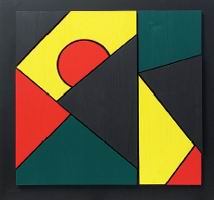Words on the Oľga Koreňová and Stano Koreň exhibition
Bohumír Bachratý
The husband and wife team of Oľga and Stano Koreň were significant employees of ÚĽUV after the year 1954. Their “Textile and Wood” are a contemporary classic featuring their unique symbiosis of material, traditional technologies and techniques with the modern spirit of utilitarian as well as the free art of the second part of the twentieth century.
Oľga Koreňová (1933-2003) worked in ÚĽUV from 1956 to 1993. Her work is characterized by utilitarian textile – a variety of designs for fabric rolls, carpets, covers and pillows. She also crafted elegant and gracious table settings and tablecloths as well as traditional tapestries that are both very attractive visually as well as by touch due to their natural sheep wool feel.
The foundation of the creations of Oľga Koreňová was always clear, stressing the pure structure of the material in the original white of the cloth as well as classic colours and shades of red, blue, ochre and green. Ornament forms the source of almost poetic harmony of these textiles, executed in a horizontal line, flowing through the surface of the textile as well as penetrating the interior space and human time. Oľga Koreňová’s textiles are made from traditional materials such as wool, cotton, flax, wool – all unequivocally pointing to the heritage of our ancestors, folk crafts and village culture.
Stano Koreň (1935) started as a carver and became a leading designer working with wood. He is the author of unique sculpture opuses, free sculptures and relief. After graduating from secondary art school, he went to work for ÚĽUV. Exploratory trips and experience meeting local folk craftsmen throughout Slovakia held Stano in great stead. He met many original and unique carvers, tub makers, carpenters and turners, manufacturers of musical instruments, shepherds’ dishes and bells. The utilitarian spirit prevailed at the beginning of his work. He created mainly table settings, sets of vessels featuring a unique style and unified shape: bowls, plates, chopping boards, trays, vessels and cutlery. After 1960 sculpture creations started to prevail. Several of Stano Koreň’s candle holders were poetic, small sculptures – verticals. He mainly used fruit tree wood to make them since it has an impressive colour and structure. Chestnut, plum, cherry, apple, linden and poplar were used mainly in their natural shape. However, he also sometimes used polychrome and dark pigment colours (black or brown) to decorate them. The basic technique he used was based on traditional turning, but transformed to modern design and featuring a style so expressive that the work could lose its original shape and utility. In this aspect, Stano Koreň’s inspirations are closer to the geometric spirit of artistic modern. In his statues and reliefs from around 1980 (as well as later) we often meet the topic of the family and groups of people, combinations and variations with dominating round and wavy profiles. Some of his biblical motifs implemented after 1990 feature Christian symbolism (Madonna, Pity, and Crucifying).
New and surprising are his works with colourful, constructive abstracts, sculptures and reliefs implemented after 2000, which were displayed for the first time at this exhibition.
